Critical Auto Cannabis Strain Week-by-Week Guide
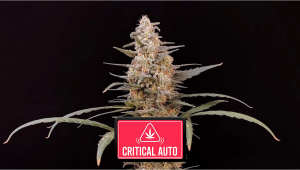
- 1. Grow specifications
- 2. Grow set up
- 3. Germination and seedling stage | week 1
- 4. Early veg | week 2
- 5. Mid veg | weeks 3-4
- 6. Transition (pre-flower) | week 5
- 7. Early flower | weeks 6-7
- 8. Mid flower (bulk phase) | weeks 8-9
- 9. Ripening and harvest | weeks 10-11
- 10. Yield and smoke report
- 11. In conclusion
Critical Auto is our own improved autoflowering version of Critical Mass, arguably the most famous creation of Spanish breeders. As the name implies, the strain produces massive harvests, and it does so for anybody—from the seasoned veteran to the complete noob. Of course, Critical Auto’s popularity also depends almost as much on its relaxing and happy high and the classic flavor of citrus and pine.
In our Critical Autoflower week-by-week guide, we’ll try to get as many insights as possible from two grow cycles performed by the same gardener. Both were spectacular, but one brought better yields and denser buds. Read on to get a feel of how Critical Auto performs throughout her life cycle.
1. Grow Specifications
Critical Auto is a well-balanced hybrid with only a slightly stronger Indica influence (60/40). It’s all about balance in every other respect, too. This autoflower is absolutely reliable and, as such, perfect for beginners who can count on a generous 350–550 gr/m2 (1.1–1.6 oz/ft2) indoors. Outdoors, the strain is equally high-yielding and brings 50–150 grams (2–5 oz) per plant. It’s a very good result for a plant that doesn’t get taller than 90–120 cm (35–47 inches). And like any good autoflower, our Critical Auto rushes through her whole life cycle in mere 10 weeks. At the end of this short wait—and after another 2-3 weeks of curing—you’ll get to enjoy Critical’s perfect high. It’s strong because it’s fueled by up to 20% THC, but it’s also balanced. You’ll be relaxed and happy, full of bright ideas and insights, and also uplifted and motivated enough to act on those creative impulses. The classic terpene profile with lemon, pine, and floral influences and earthy background adds to the experience.
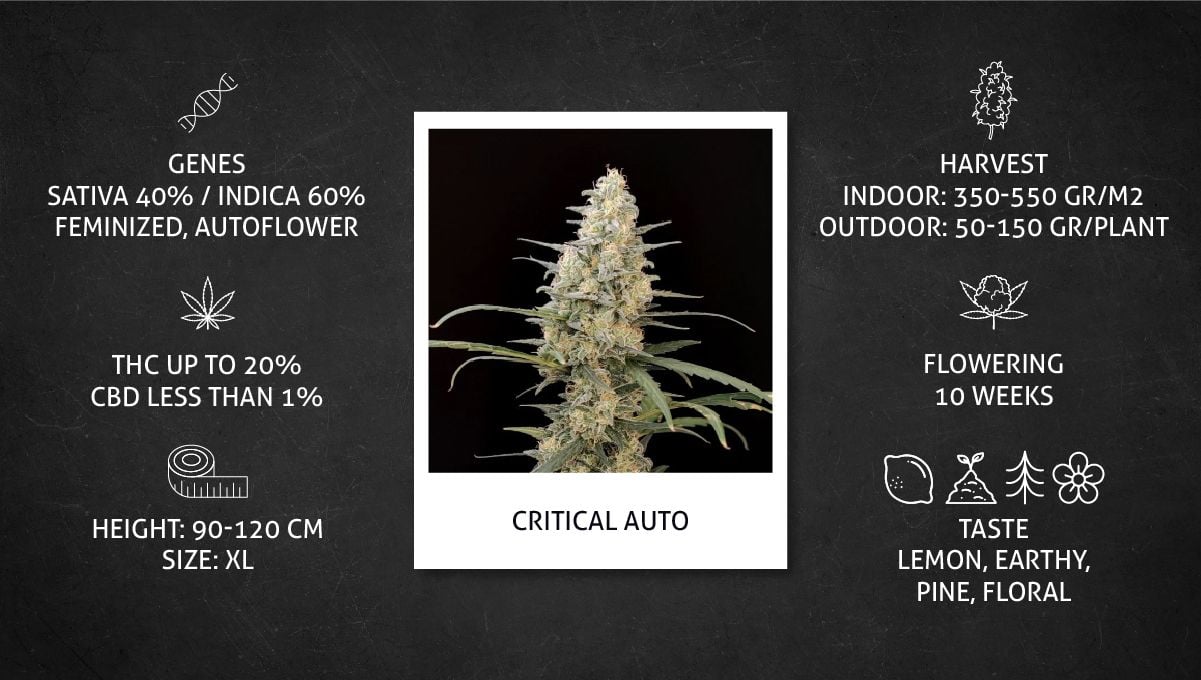
So, when is the best time to fire up your Critical Auto flowers? Well, this variety destroys the stereotype of autoflowering strains. These varieties weren’t the strongest back in the day, but modern breeders have managed to bring them up to potency standards that rival many photoperiod cultivars. Because this strain has a high THC content, most cannabis users choose to reserve her for quiet evenings spent chilling out. Although Critical Auto will plunge you into a state of euphoria, her lively terpene profile also helps to supercharge the mind. While your body feels relaxed, your brain will get the itch to create something! Therefore, you might find that hitting a bowl loaded with these flowers will help you write, paint, and make music!
2. Grow Set Up
Let’s study in detail Critical Auto timeline based on two consecutive grows done by the same grower—Mr_Weeds_Auto. He cultivates his autoflowers indoors, in a 2’x4’ tent, under a 300W Vivosun LED light. There’s nothing special about the rest of his setup either: an exhaust fan coupled with a carbon filter and 4 desk fans to move the air inside the tent. The guy also takes the issue of humidity seriously, using a hygrometer and a mist humidifier.
| Grow Space: | 0.74 m2 (8 ft2) | Pot Size: | 6.32 l (1.67 gal) |
|---|---|---|---|
| Seed to Harvest: | 11 weeks | Medium: | Potting soil |
| Flowering: | 7 weeks | Nutrients: | Synthetic |
| Light Cycle: | 18/6 | pH Levels: | 6.2–6.3 |
| Light Type: | LED | Day Temperature: | 25–26°C (77–79°F) |
| Watts Used: | 300 | Humidity: | 60% ↘ 47% |
3. Germination And Seedling Stage | Week 1
There are indoor gardeners who keep their cannabis seedlings at 24/0, but most of us prefer a more natural schedule. In this grow cycle, it was a comfortable 18/6 with a day temperature of 79°F (26°C) and only slightly cooler nights. Exactly what seedlings prefer.
The grower also made sure to keep the RH in the seedling stage on the higher side—at 60%—although many people go even higher—up to 70–80%. In setups where the air is especially dry, it’s even recommended to use humidity domes for young seedlings and clones.
| Plant Height: | 2“ (5 cm) | Humidity: | 60% |
|---|---|---|---|
| Distance to Light: | 24“ (61 cm) | Water per Day: | 0.07 gal (0.25 l) |
| Day Temp: | 79°F (26°C) | pH: | 6.2 |
| Night Temp: | 66°F (20°C) | Smell: | None |
Among the many germination methods, the grower chose one of the most widely used. He soaked the seed for 48 hours in a glass of water and then kept it between wet paper towels until it had a half-inch long taproot. Usually, the room temperature is enough to kickstart this process, but when it’s cooler than 70°F (21°C), you may need to use a heat mat to raise the temp a couple of degrees. Once the seed germinated, it went straight into the final 6.32 l (1.67 gal) plastic pot filled with Happy Frog soil mix. By the way, in the first run, the pot was bigger—3 gallons—but the yield was about the same, even less. It’s a feature of autoflowers: their life cycle is short and their size limited, so using bigger containers doesn’t necessarily translate into bigger yields. It’s only so much medium that the root system of an auto can use up before the flowering kicks in and the root development stops.
There are many things you can do to make sure your Critical Auto seedlings get the best start in life possible. Firstly, you can maximise root health and stave off disease by inoculating your soil with mycorrhizal fungi, trichoderma, and rhizobacteria. These microbial species will help with nutrient uptake, shield against stress, and protect vulnerable seedlings from fungal diseases. Next, you should expose your seedlings to light the second that shoots emerge from the soil. Optimal light intensity at this time will help to prevent legginess and produce strong seedlings with robust stems.
At first, the grower was only misting his seedling to locally raise the humidity, and then he started to give her a cup (250 ml) of water every 3 days. Since he was using Happy Frog potting soil, he didn’t need to add any nutrients just yet.
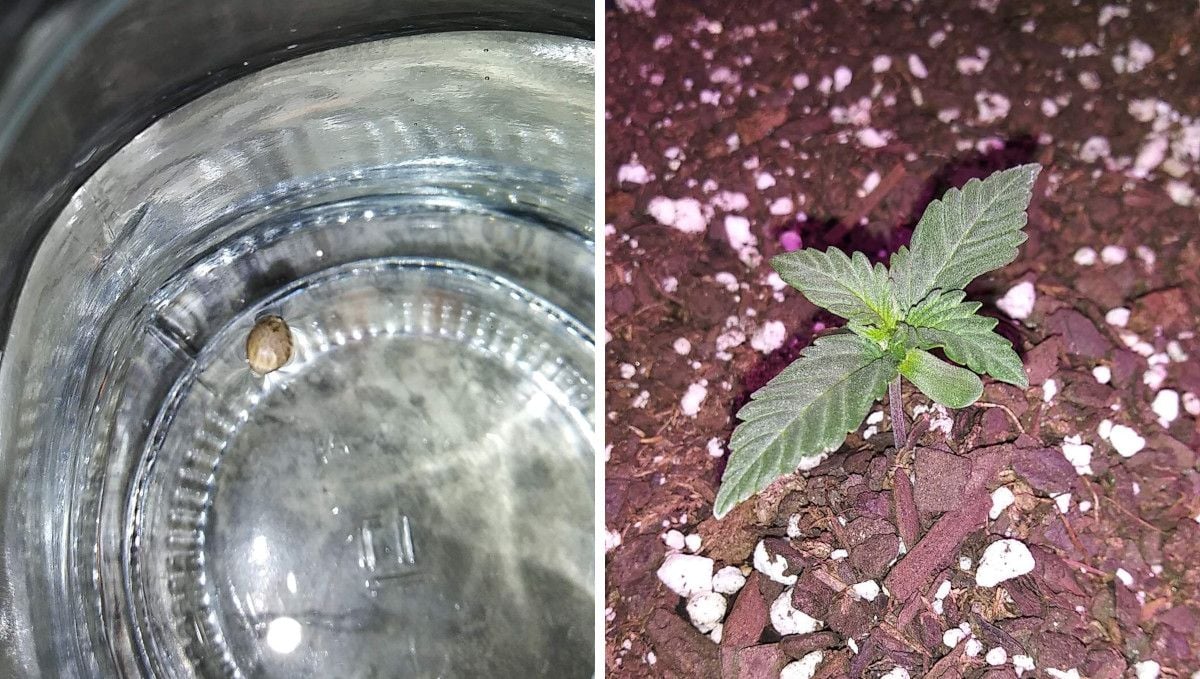
4. Early Veg | Week 2
In week 2, a cannabis seedling isn’t as fragile as it was in the previous week. It has a bigger root structure that can well compensate for the evaporation of water from the leaves. So you don’t need to keep the relative humidity of the air as high as before.
| Plant Height: | 3.5” (9 cm) | Humidity: | 47% |
|---|---|---|---|
| Distance to Light: | 36” (91 cm) | Water per Day: | 0.07 gal (0.25 l) |
| Day Temp: | 79°F (26°C) | pH: | 6.2 |
| Night Temp: | 68°F (20°C) | Smell: | None |
The grower faced the issue of too much chlorine in his tap water. This chemical not only makes water a little bit more acidic but can be detrimental to the health of your plants. Usually, it’s easy to get rid of chlorine by simply letting it stand for 24 hours. But this time the grower had to actually boil it for 15-20 minutes because the excess chlorine made the leaves on Critical Auto and other seedlings look weird.
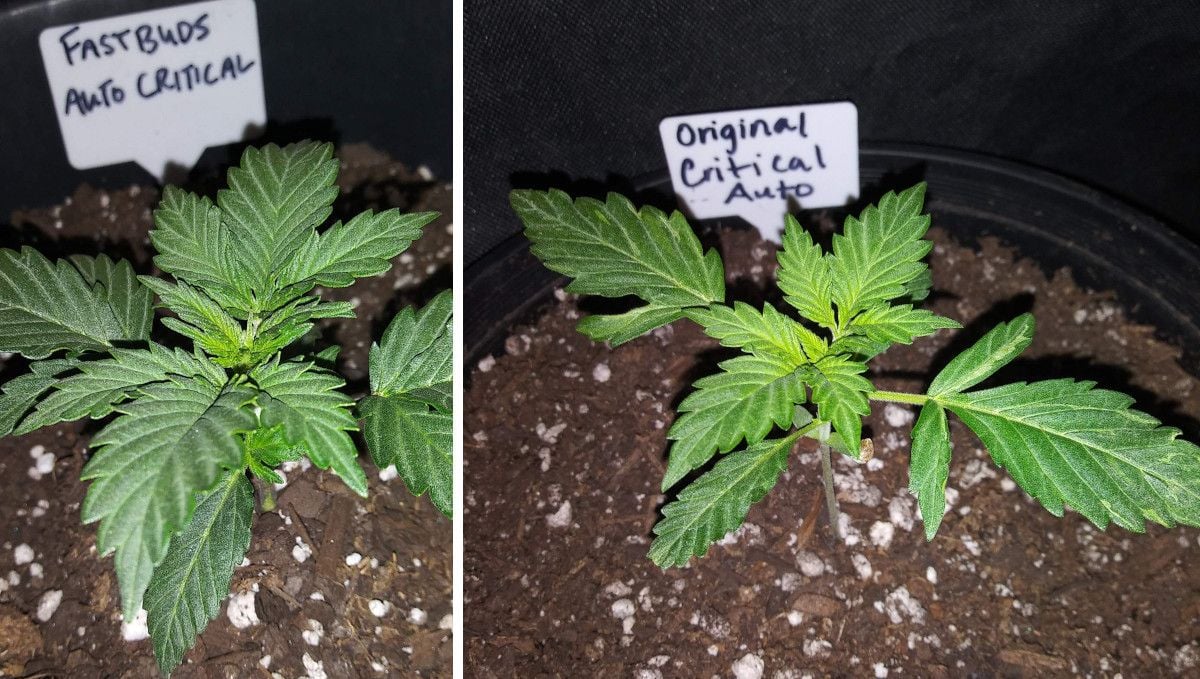
He still didn’t add any fertilizers because 6 liters of good potting mix contain enough nutrients for at least a couple of weeks. Of course, cannabis plants need nutrients in the early stages of growth to facilitate key physiological processes. Nitrogen is especially important during this time. This element forms a key part of amino acid molecules—the building blocks of larger proteins that contribute to plant structure. However, too much nitrogen can result in toxicity and have a detrimental effect on plant growth. Unless you’ve sowed your seeds within nothing but coco coir, peat, and perlite, you won’t need to add additional inputs during these early stages.
5. Mid Veg | Weeks 3-4
This part of the vegetative phase is the time when you start noticing significant changes every day. It’s because side branches begin to grow vigorously while the main stem continues to stretch, producing a couple of new nodes. For a photoperiod strain, it can be just the beginning of grow stages, but for an auto, the veg usually stops by the end of the first month.
| Plant Height: | 6–16” (15–41 cm) | Humidity: | 47% |
|---|---|---|---|
| Distance to Light: | 36” (91 cm) | Water per Day: | 0.07 gal (0.25 l) |
| Day Temp: | 77°F (25°C) | pH: | 6.2–6.3 |
| Night Temp: | 68°F (20°C) | Smell: | Weak |
The grower didn’t regret using a smaller pot this time because Critical Auto seemed even bigger than in the previous run. He also decided to wait with giving his girl extra nutrients because last time, Critical Auto didn’t benefit from nitrogen-rich food and even displayed symptoms of N toxicity.
He also noticed that the plant reacted better to slightly cooler temps, so he made sure to keep the day temperature at 77°F (25°C) compared to 79°F (26°C) in the previous cycle. Frankly, it’s all within the ideal range for cannabis in the vegetative phase, but such fine-tuning allows you to get a couple of extra grams at harvest.
Another difference was the distance from the light. The grower kept it at 36 inches (the previous time it was 24”). With less amount of light, Critical Auto looked even more vibrant—tall and branchy—and one could probably low-stress train her for better results, but the guy decided to let her grow naturally.
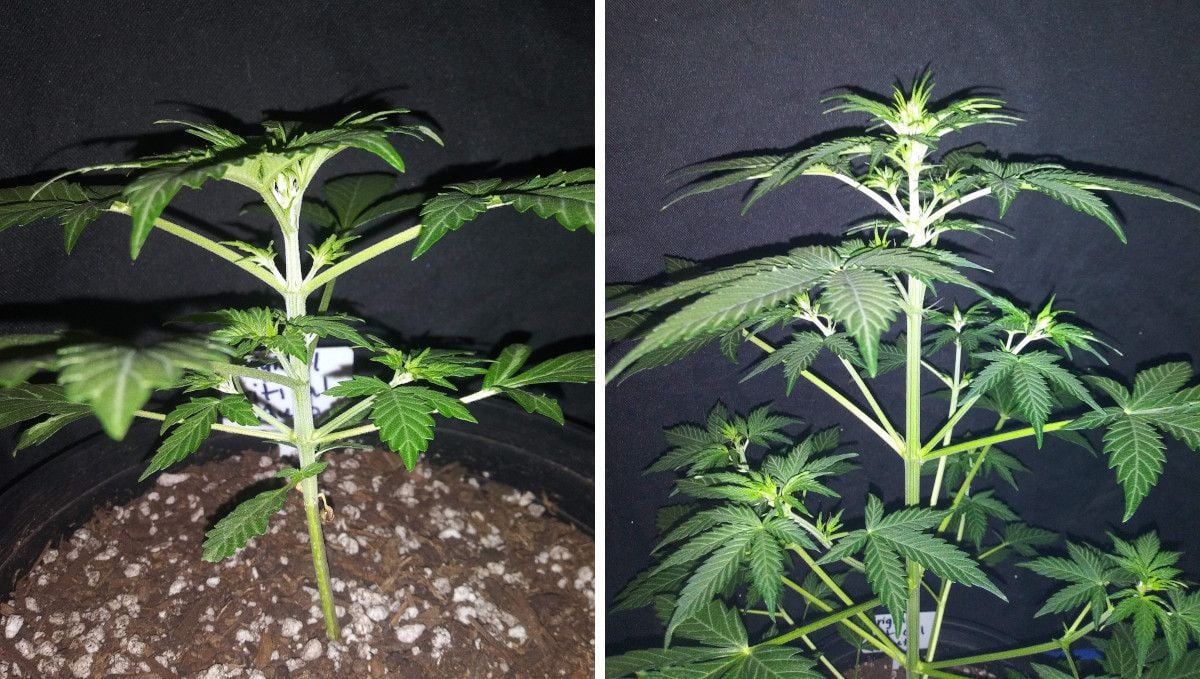
6. Transition (Pre-Flower) | Week 5
Autoflowers enter the pre-flowering stage sometime at the end of the first month. If you look closely, you will notice the first hairs at the nodes—that is on the main stem at the base of every side branch. Pre-flowers mean that the plant is mature and ready to flower. The next thing that you’ll notice is the emergence of the same kind of hairs on every top. The tops will also be a lighter shade of green, almost yellow, very hard to miss.
| Plant Height: | 24.5” (62 cm) | Humidity: | 47% |
|---|---|---|---|
| Distance to Light: | 36” (91 cm) | Water per Day: | 0.13 gal (0.5 l) |
| Day Temp: | 77°F (25°C) | pH: | 6.3 |
| Night Temp: | 68°F (20°C) | Smell: | Weak |
In the picture below, you can see to what extent you can control the height and structure of your cannabis by adjusting the light distance. The distance was some 50% greater in the second cycle and resulted in a taller plant.
Taller plants are easier to work with. Shorter ones spend less energy on the transport of water and nutrients to the bud sites, but they’re less convenient to handle, including watering. And in this case, the grower had to defoliate quite a bit because the lower leaves were in the shade and started to yellow. Also, taller plants are better suited to the sea-of-green method.
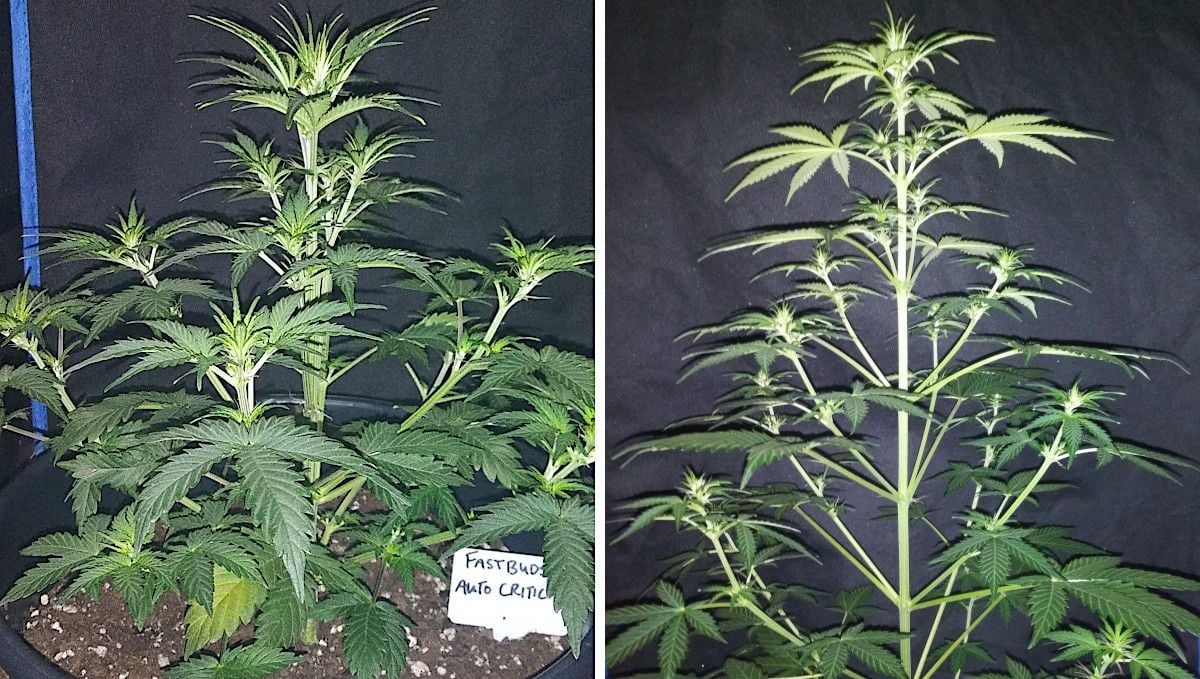
Week 5 was the first one when the grower used any nutrients. Critical Auto had run her whole veg on nothing but amended soil and tap water. And since she didn’t really need much nitrogen now, she was only getting flowering nutrients and micronutrients from now on.
The staple of the diet was General Hydroponics FloraBloom with its elevated levels of phosphorus (P) and potassium (K)—exactly what cannabis needs in flower. The other GHE supplement—FloraMicro—served as a source of nitrogen (only a little of it) and all lesser nutrients that plants need.
And the third formula was Botanicare Cal-Mag Plus which supplied Critical Auto with calcium and magnesium as well as iron. Cal-Mag supplements are of paramount importance if you cultivate in coco coir, but they’re also useful in soil.
7. Early Flower | Weeks 6-7
In the first weeks of flowering, the most striking change is not the formation of buds but the stretching. Novice gardeners often find out too late how much cannabis stretches in flower—often only 50% but occasionally 2 or even 3 times. It can be a problem in micro grows, so be aware of this fact and keep in mind that Sativas stretch more than Indicas.
| Plant Height: | 29–32” (72–80 cm) | Humidity: | 47% |
|---|---|---|---|
| Distance to Light: | 36” (91 cm) | Water per Day: | 0.13 gal (0.5 l) |
| Day Temp: | 77°F (25°C) | pH: | 6.3 |
| Night Temp: | 68°F (20°C) | Smell: | Weak |
What with the flowering stretch and with the fattening up of the buds, a weed plant becomes very hungry and thirsty at this point. Depending on the size of your pot, you will have to water every day or every other day now. This was surely the case with this large and healthy girl. Look in the height chart below at how she grew from the very start till weeks 7-8 (when she stopped stretching):
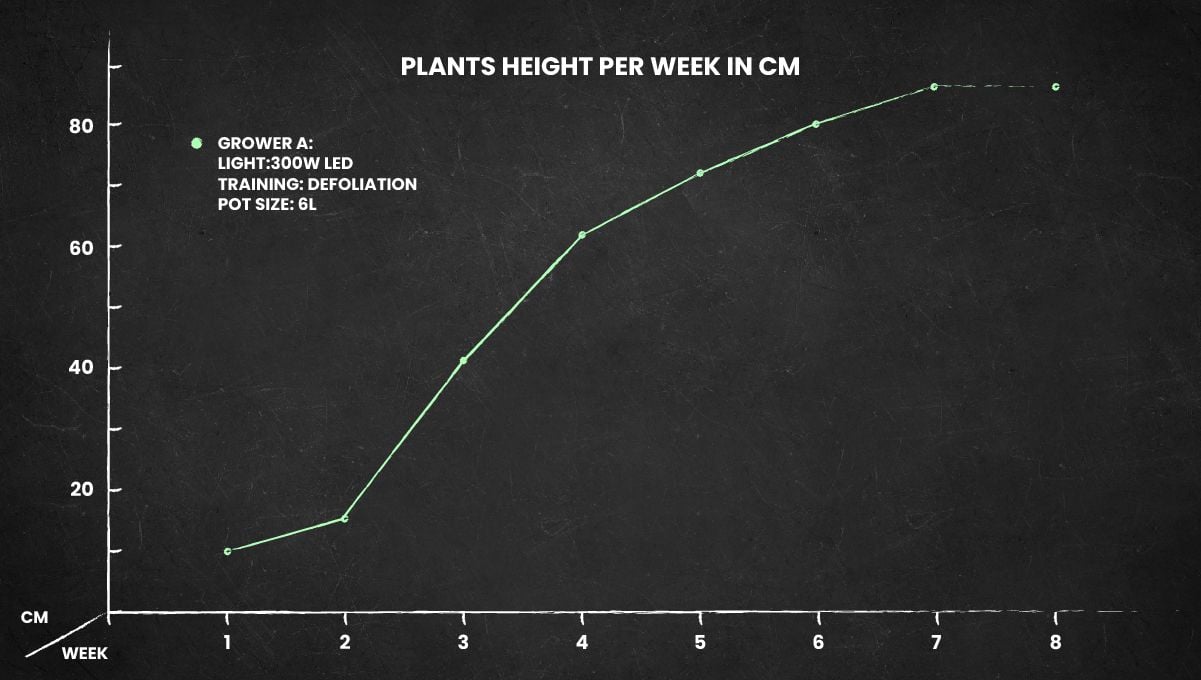
Unfortunately, the grower had to go away for three days in week 6 and left his garden unattended. When he came back, all plants were practically dying of thirst. The leaves had drooped, and the lower ones began to yellow.
In less severe cases they perk up right away—as soon as you give them some water. But this Critical Auto needed 24 hours to recover, and the lower leaves had to be defoliated. Anyway, she had grown some despite all the adversity, and in week 6, the regular watering/feeding routine continued.
The grower alternated giving his Critical Auto only pH’d water one day and a full dose of nutrients the next. If you’re a beginner, we recommend doing the same. It’s safer this way because there’s less risk of nutrient burn. Alternatively, you can add nutrients with every watering but cut down on the dosage.
By week 7, the plant looked perfectly healthy again, and the buds were filling out nicely.
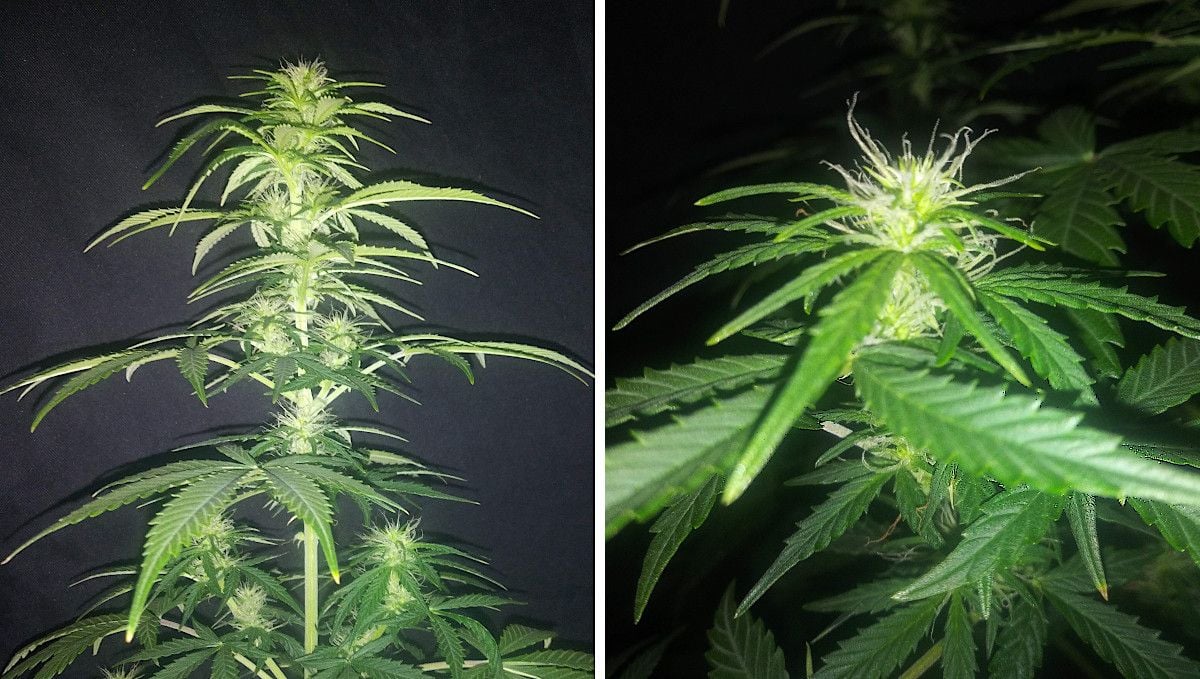
During the budding stage, it’s important to control the temperature, keeping it within the comfortable range of 73–79°F (23–26°C). Please note that in flower, the air should be a bit cooler than in veg.
Things were good in this respect during the second run with Critical Auto. Unlike the first one—when the temps got out of control for a spell and resulted in some issues as seen in the picture below. The grower diagnosed it as calcium deficiency, but it was probably just heat stress. Or maybe both.

8. Mid Flower (Bulk Phase) | Weeks 8-9
When cannabis is 4 weeks into flowering, the stretch usually comes to an end, and the plant focuses on filling out the buds and producing trichomes. The appetite remains the same, and developing flower clusters require more and more phosphorus and potassium. The colas get so bulky, that there’s a risk of mold inside them. So, if you haven’t yet lowered RH to something like 35–45%, now is the time.
| Plant Height: | 34” (86 cm) | Humidity: | 47% |
|---|---|---|---|
| Distance to Light: | 36” (91 cm) | Water per Day: | 0.13 gal (0.5 l) |
| Day Temp: | 77°F (25°C) | pH: | 6.3 |
| Night Temp: | 68°F (20°C) | Smell: | Normal |
The grower was happy that his tweaking of environmental conditions and growing techniques made Critical Auto such a monster. He had to support the main stalk with a rigid wire. Otherwise, it would bend and probably snap under the weight of the main cola. It happens a lot during cannabis flowering stages.

Let’s compare her with her predecessor in the pic below. That plant was subjected to heat stress, and she largely overcame it. The only thing that remained was foxtailing—when each flower cluster tries to distance itself from the rest.

The grow was practically on cruise control now (which is often the case with good genetics during flowering time). The guy only had to remove a dying lower leaf here and there and to water (or feed) his Critical Auto every other day. By the way, whenever you notice a yellow or dead leaf at different stages of flowering, it’s perfectly normal. It only means that there’s a healthy nitrogen deficiency. It’s much better than nitrogen toxicity because too much N interferes with the budding process. Let’s look at the entire nutrient schedule for this grow. It was simple bordering on primitive but quite effective.
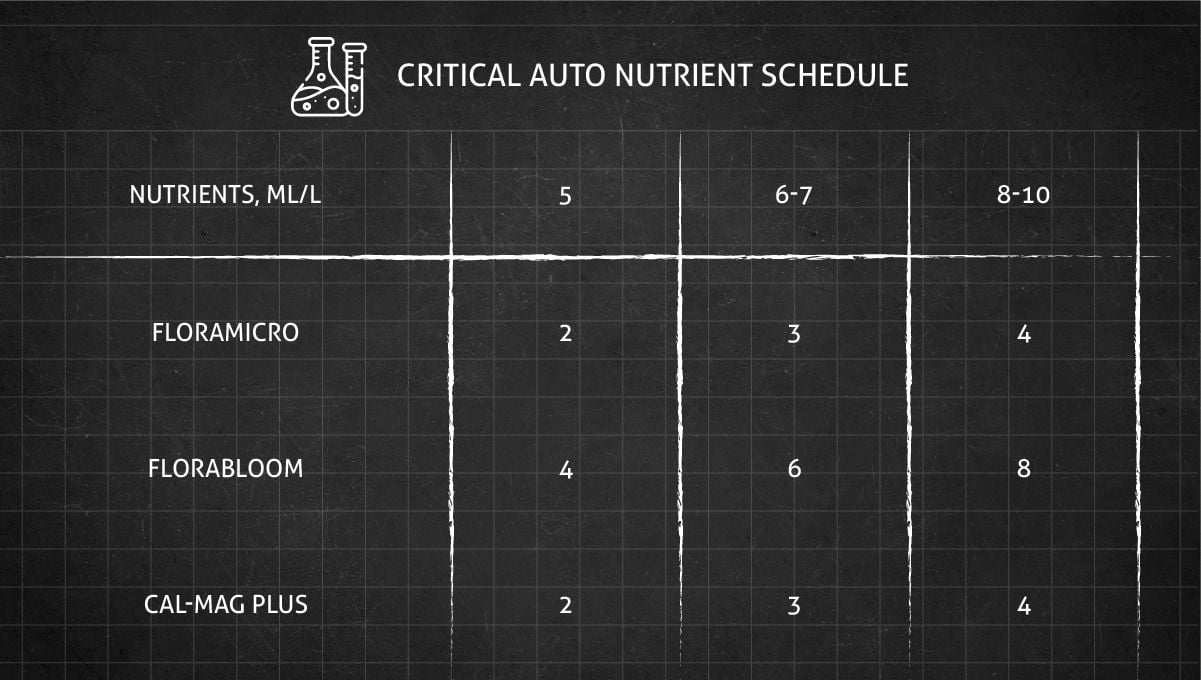
9. Ripening And Harvest | Weeks 10-11
The last couple of weeks is a great time to lower the day temperature a bit and to also make the nights slightly cooler. (See the table.) This artificial autumn will facilitate the fade and the maturing of the buds. But it’s also important to decrease the humidity because lower temps and higher RH are a perfect recipe for a mold outbreak.
| Plant Height: | 34” (86 cm) | Humidity: | 40% |
|---|---|---|---|
| Distance to Light: | 12” (30 cm) | Water per Day: | 0.13 gal (0.5 l) |
| Day Temp: | 75°F (24°C) | pH: | 6.3 |
| Night Temp: | 65°F (18°C) | Smell: | Strong |
Newbie growers often don’t realize the importance of the last weeks before harvest. It might seem that your plant has stopped changing and nothing is happening. But it isn’t so. First of all, the buds can still get fatter. Second, even if they stay the same size, they become heavier. But the most important process now is the maturation of the trichomes. To a naked eye, trichomes, these tiny resinous glands on buds and “sugar leaves”, may look the same from the day they appear and to the day you chop your cannabis. But in fact, they do change very much. You just need a hand microscope to see it.
So buy one and when the harvest is near, start inspecting the trichs every day. The perfect harvest window comes when most of the trichomes are milky and some amber. With clear trichomes, the smoke would be less potent (and more in the head). And if you wait for the majority of trichs to turn amber, the effect will be more sedating because amber color means that THC has started to degrade to cannabinol.
And when the process of trichomes turning from clear to milky has begun, it’s time to stop giving your plant any nutrients and letting her drink only pure water. This is called flushing, and its purpose is to clean first the medium and then the tissues of the plant from built-up salts. When growing in soil, one or two weeks of flushing are enough.
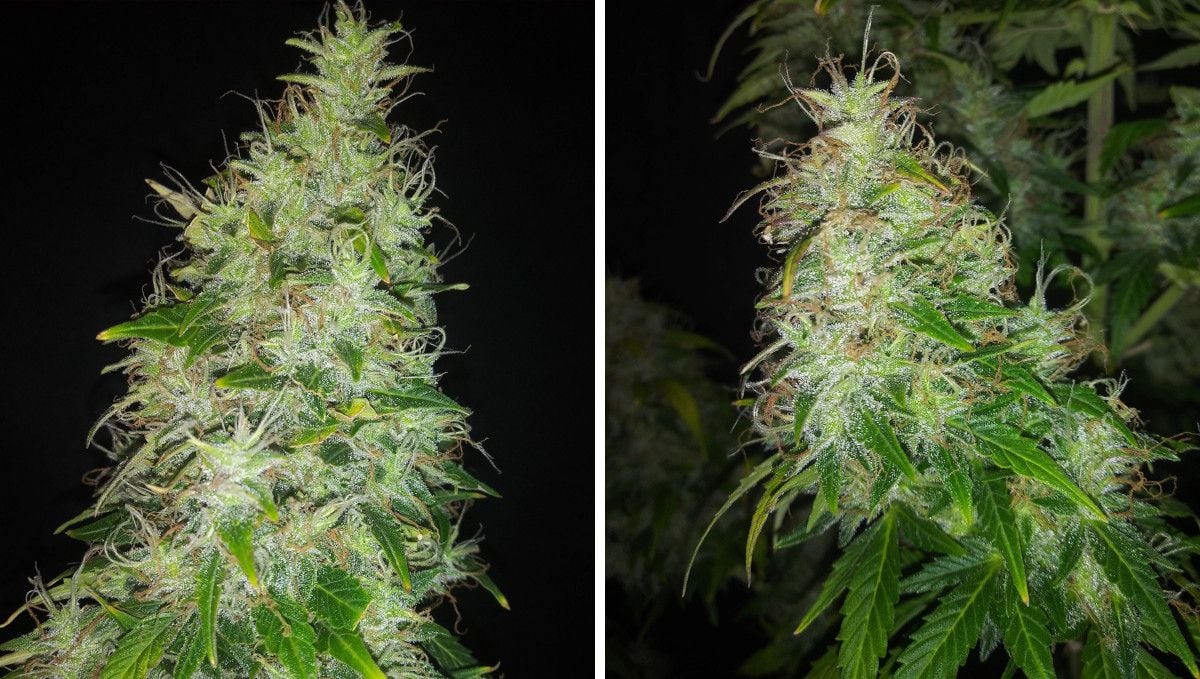
10. Yield and Smoke Report
As we have said before, Critical Auto did good in both runs and yielded about the same and in the same 11 weeks from seed. This time, the grower got 1.91 oz (54 g) dry although he used a smaller container and didn’t train his lady at all. As you can judge by the pic below, trimming her was a breeze: there were very few leaves sticking out the bloated and dense colas.
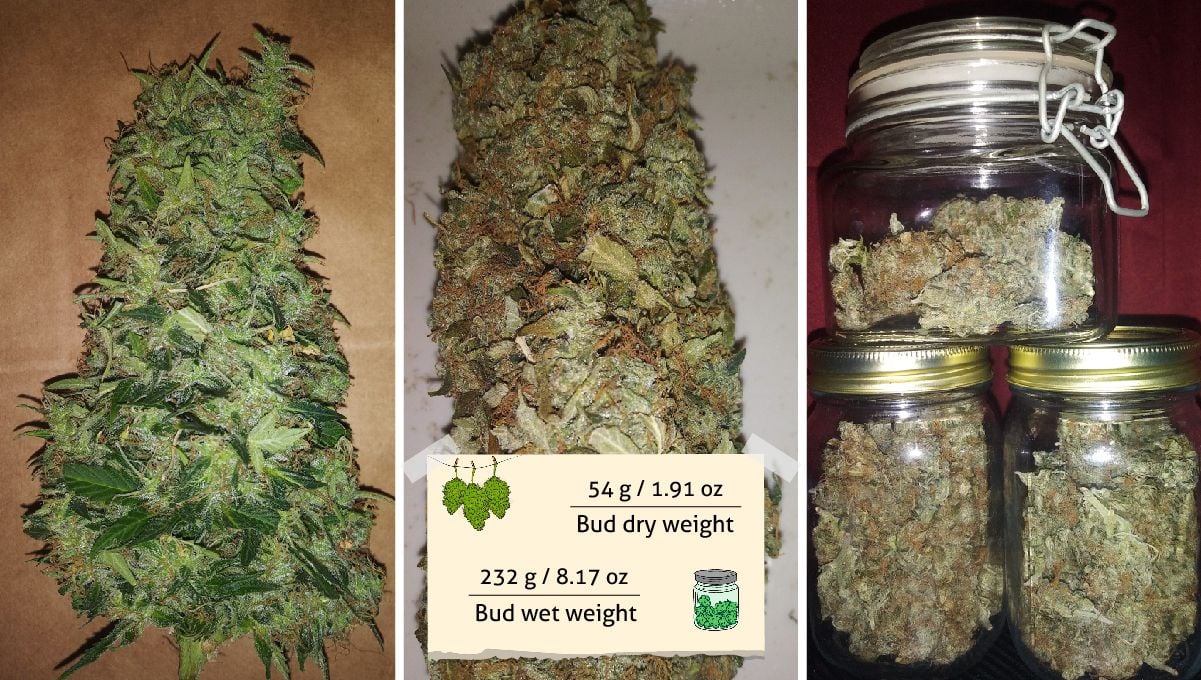
The guy also liked the effect. Well, duh, otherwise he wouldn’t have grown this strain again in the first place.
After lighting it up, there will be an immediate effect that is deeply relaxing. A balanced hybrid that will provoke creativity as well as a physical body effect that is both calming and serene. A great choice for social nights out, musicians, artists, gaming, or chilling with friends watching movies. Be warned that smoking too much can leave you in a dream state that can last for hours.
Mr_Weeds_Autos
11. In Conclusion
Critical Auto is truly a classic that deserves to still be around after so many years. She is perfectly low-maintenance and doesn’t require any training to yield well. You don’t need expensive fancy nutrients either. In this cycle, the feeding schedule was exemplary simple, but the end result was excellent.
The strain is also stabilized and uniform. We didn’t see much difference between the plants in the first and second runs. And those differences that were present were due to the change in environment: light distance and temperature.
In short, Critical Auto is a reliable and easy-to-grow strain that will appeal to novices and bring experienced gardeners great yields.
External References
- Models of Cannabis Taxonomy, Cultural Bias, and Conflicts between Scientific and Vernacular Names, The Botanical Review, June 2017
- Discriminating the Effects of Cannabis sativa and Cannabis indica: A Web Survey of Medical Cannabis Users, Journal of alternative and complementary medicine, September 2014








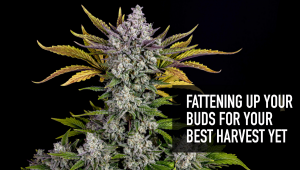
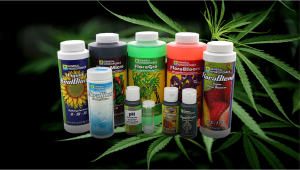
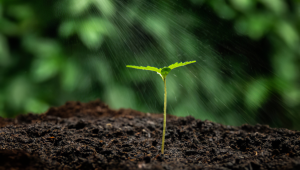
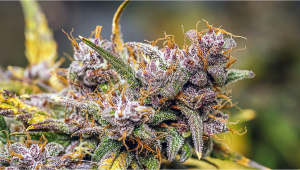


Comments